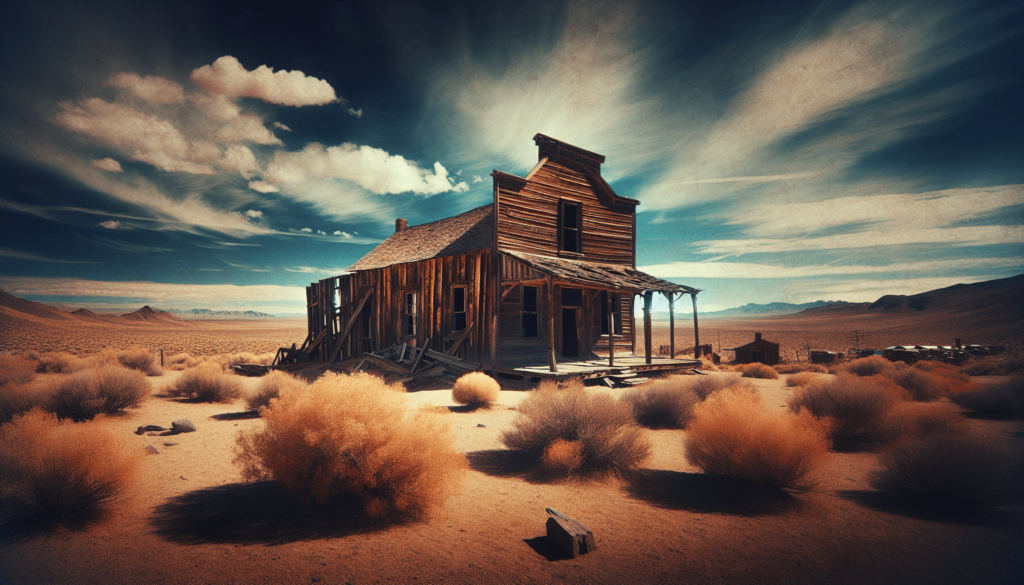Imagine stepping into a world where the whispers of the past meet the silence of the present, right in the heart of Arizona. “Mysteries of White Hills: An Arizona Ghost Town Chronicle” invites you on a captivating journey to explore the enigmatic White Hills Ghost Town, Arizona. This exploration not only promises to unfold the layers of stories that this deserted town silently guards but also offers a unique glimpse into the lives that once thrived here. From the echoes of miners’ picks striking gold to the abandoned structures that now stand as silent sentinels of time, prepare to be mesmerized by the rich history and intriguing tales that White Hills holds.
The Rise and Fall of White Hills
Origins of the town: Discovery of silver
Imagine stepping back in time to the late 1800s in Arizona, a period when the glint of silver caught the eye of prospectors and dreamers alike. Your journey into the history of White Hills starts with a remarkable discovery of silver, sparking a rush of opportunity-seekers to this area. The prospect of wealth drew people from far and wide, establishing the foundations of what would soon become a bustling town. The allure of silver mining turned White Hills from a mere name on a map into a hive of activity and excitement.
Boom years and economic prosperity
During these boom years, you’d see White Hills thriving, with the population swelling as miners, entrepreneurs, and families moved in, hoping to claim their share of prosperity. The town’s economy flourished, supported by a growing network of businesses and services catering to the booming population. Silver mining wasn’t just a job; it was a way of life that brought economic prosperity to White Hills, putting it firmly on the map as a beacon of success and opportunity.
Decline: Factors leading to the town’s abandonment
But nothing lasts forever. Imagine, over time, the once-rich veins of silver began to dry up. Coupled with declining silver prices and the difficulty of deep-level mining, these factors sowed the seeds of decline. The once-bustling streets started to empty, as miners and their families left in search of new opportunities, leaving behind the echoes of prosperity. The town’s abandonment was a gradual process, accelerated by economic downturns and the harsh realities of mining life.
Current status: Preservation efforts and tourism
Today, White Hills stands as a poignant reminder of Arizona’s vibrant mining history. Efforts to preserve what remains of the town have turned it into a destination for those fascinated by the Old West and Arizona’s ghost towns. Tourism now plays a pivotal role in keeping the memory of White Hills alive, inviting you to explore its ruins and imagine the town in its heyday.
Geographical Setting
Location and significance in Arizona
White Hills is nestled in the heart of Arizona, a state known for its rich mining history. Its location played a significant role in its development, offering easy access to mineral resources and becoming a pivotal part of Arizona’s silver mining saga. The town’s geographical significance extends beyond resources, lying at a crossroads of natural beauty and historical importance.
Climate and its impact on preservation
The arid climate of Arizona has played a dual role in the story of White Hills. On one hand, the dry conditions have helped preserve the architectural remnants and artifacts, keeping the town’s legacy alive. On the other hand, the harsh sun and occasional harsh weather conditions continue to erode what’s left, making preservation efforts all the more crucial.
Nearby landmarks and natural features
Surrounding White Hills are landmarks and natural features that echo Arizona’s diverse landscapes. Not far from the ghost town, you can discover natural wonders, each telling its own story of geological and historical significance. These landmarks not only add to the allure of visiting White Hills but also provide a broader context of the region’s beauty and challenges.

This image is property of images.pexels.com.
Famous Residents and Personalities
Prominent miners and entrepreneurs
In the heart of White Hills’ bustling days, certain figures stood out. Prominent miners and entrepreneurs, driven by the dream of striking it rich, became the backbone of the town. Their stories, filled with ambition and often hardship, paint a vivid picture of the pursuit of prosperity in the Wild West.
Lawmen and outlaws: Stories of conflict
No tale of a mining town is complete without the legendary conflicts between lawmen and outlaws. White Hills, with its wealth and lawlessness, attracted its share of both. The stories of shootouts, standoffs, and the quest for justice are integral to the town’s lore, adding a layer of excitement and danger to its history.
Everyday life: The unsung heroes of White Hills
Beyond the tales of riches and rivalry lie the stories of the everyday people of White Hills. The unsung heroes – the families, the shopkeepers, the teachers – were the ones who truly shaped the town, creating a community in the midst of chaos and uncertainty. Their resilience and adaptability are central to understanding the heart of White Hills.
Architectural Heritage
Construction styles of the late 1800s
The buildings of White Hills, though now mostly ruins, speak of the architectural styles of the late 19th century. Constructed with the materials and techniques available at the time, these structures reflected the practical needs and aesthetic aspirations of their builders, from simple homes to more ambitious buildings signifying prosperity and progress.
Preserved buildings and ruins
Among the whispers of the past, some buildings and ruins in White Hills have stood the test of time better than others. These preserved pieces of history offer a tangible connection to the town’s heyday, inviting you to walk through the past and imagine life as it was lived.
Comparative analysis with other ghost towns
When compared to other ghost towns, White Hills offers a unique glimpse into the silver mining era in Arizona. Each town has its own story, defined by its people, economy, and eventual decline. Yet, White Hills stands out for its particular blend of economic ambition, architectural heritage, and the enduring spirit of its residents.

This image is property of images.pexels.com.
Economic Activities
Silver mining operations and techniques
The heartbeat of White Hills was undoubtedly its silver mining operations. The techniques and tools used in the search for silver were a testament to the miners’ determination and ingenuity. From simple picks and shovels to more sophisticated methods of extraction, the evolution of mining techniques tells a story of human endeavor against the might of nature.
Supporting businesses and services
As the mining operations flourished, so did a network of supporting businesses and services. General stores, saloons, brothels, and blacksmith shops sprang up, creating a micro-economy centered around the miners’ needs and leisure. These establishments were vital to the social and economic fabric of White Hills, providing goods, services, and a semblance of normalcy amid the town’s frenetic pace.
Impact of economic downturn on the community
The economic downturn that led to the decline of White Hills had far-reaching effects on its community. As jobs disappeared and hopes faded, the once-thriving town faced poverty, abandonment, and a loss of identity. The impact was not just economic but also deeply personal, affecting generations of families who had called White Hills home.
Cultural and Social Life
Social gatherings and entertainment
Despite the hardships, the residents of White Hills found ways to come together and enjoy life. Social gatherings, whether at saloons, community events, or impromptu get-togethers, provided much-needed relief from the rigors of mining life. Entertainment, in the form of music, dancing, and storytelling, was a vital aspect of the town’s cultural and social life.
Religious practices and institutions
Religion played a significant role in the daily life of White Hills, offering spiritual comfort and a sense of community. Churches and religious gatherings were central to the town’s social fabric, providing moral guidance and a place for communal support and fellowship.
Education and schooling during the town’s prime
In the midst of economic boom and bust, the importance of education remained constant. The establishment of schools in White Hills reflected the community’s commitment to ensuring a better future for their children. Schooling during the town’s prime offered a glimpse of normalcy and hope, preparing the next generation for life beyond the silver mines.

This image is property of images.pexels.com.
Legends and Paranormal Claims
Famous ghost stories and sightings
White Hills, like many ghost towns, is shrouded in tales of the supernatural. Legends of ghost sightings and unexplained phenomena have become part of the town’s mystique, drawing both skeptics and believers to explore its ruins. These stories, whether rooted in fact or fiction, add a layer of intrigue to the town’s history.
Investigations: Separating fact from fiction
Over the years, investigations into the paranormal claims surrounding White Hills have sought to separate fact from fiction. These efforts, ranging from amateur ghost hunters to more scientific approaches, have worked to uncover the truth behind the legends, contributing to the town’s allure as a place of mystery.
Cultural impact of the town’s mysterious allure
The legends and paranormal claims of White Hills have had a significant cultural impact, inspiring books, films, and folklore. The town’s mysterious allure captures the imagination, inviting us to ponder the thin veil between the past and present, the known and the unknown.
Archaeological Findings
Discoveries from recent excavations
Recent archaeological excavations in White Hills have unearthed a wealth of artifacts, offering insights into the daily lives of its former residents. From household items to mining tools, these discoveries paint a detailed picture of the town’s economic activities, cultural practices, and social dynamics.
Artifacts and their historical significance
Each artifact, with its own story to tell, contributes to our understanding of White Hills and its place in Arizona’s mining history. These items, carefully preserved and studied, are vital pieces of the puzzle, revealing the complexities of life in a 19th-century mining town.
Insights into daily life and technologies of the era
The archaeological findings in White Hills provide valuable insights into the daily life and technologies of the era. By examining these artifacts, we can gain a deeper appreciation for the ingenuity, resilience, and spirit of those who lived and worked in the town, faced with the challenges of their time.

Conservation and Ethical Considerations
Preservation of historical sites vs. natural decay
The debate between preserving historical sites like White Hills and allowing natural decay to take its course is ongoing. Preservation efforts aim to maintain the town’s architectural and historical integrity, while some argue for letting nature reclaim what remains, reflecting the transitory nature of human endeavors.
Ethical tourism in ghost towns
Ethical tourism plays a crucial role in the conservation of ghost towns like White Hills. Visitors are encouraged to explore these sites with respect and mindfulness, minimizing their impact on the fragile ruins and artifacts. By promoting responsible tourism, we can ensure that these historical treasures are preserved for future generations to explore and learn from.
Impact of modern visits on the site’s integrity
Modern visits to White Hills, whether by tourists, researchers, or ghost hunters, have a significant impact on the site’s integrity. Each footstep, each removed artifact, subtly alters the town’s landscape. Balancing the desire to explore with the need for preservation is key to maintaining White Hills as a portal to the past, allowing us to connect with the spirit of the Old West.
Future Prospects
Potential for archaeological discoveries
The future of White Hills offers exciting possibilities for archaeological discoveries. Continued excavations and studies have the potential to unearth more artifacts, shedding further light on the town’s history and the lives of its inhabitants. Each discovery adds a new chapter to the story of White Hills, enriching our understanding of its place in Arizona’s heritage.
Sustainable development and tourism
Looking ahead, sustainable development and tourism are crucial for preserving White Hills while making its history accessible to a wider audience. Efforts to protect the site and promote ethical tourism practices will ensure that the town remains a living classroom and a window into the past, offering invaluable lessons on the human spirit’s resilience and adaptability.
The role of technology in preserving history
Technology offers powerful tools for preserving and interpreting the history of White Hills. From digital reconstruction and virtual tours to advanced archaeological methods, technological innovations are opening new frontiers in how we engage with and preserve historical sites. By harnessing these tools, we can bring the story of White Hills to life for a global audience, ensuring that its legacy endures for generations to come.
White Hills Ghost Town Arizona stands as a testament to the hopes, hardships, and human stories etched into the landscape of the American West. Its ruins and memories invite you to explore, learn, and reflect on the fleeting nature of fortune and the enduring spirit of those who dared to dream.


